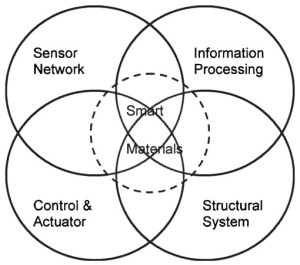Structural Engineering is an evolving field. Our profession continues to innovate with brilliant new technology, materials, and analysis methods, at an ever increasing pace. I can remember when I started as a junior structural engineer in 1983, the introduction of personal computers was just beginning to take place, along with the finite element method for structural analysis. This was a significant step forward from the previous generation of engineers who grew up on slide rules. After 33 years, I’m still learning.
What are Smart Structures? Think of the human body. It is by far the most advanced and technologically “Smart Structure” that exists. Let’s recap what a conventional structure is: A building is subjected to a lateral wind pressure load and reacts by transmitting these loads through its structural system (e.g., steel/concrete/masonry/wood) to the foundation. The structural stiffness response is the same regardless of the wind pressure. Whether it’s a hurricane force wind or a mild 10 mph wind gust, the building’s stiffness, damping, and structural response are identical. Reaction forces, internal stresses, and deformations will change, but the stiffness distribution remains constant. This is a conventional structure.
A Smart Structure will adjust the stiffness, damping, and material properties to respond to the loading, and shift the internal stiffness accordingly as it pertains to the demand. Think of the human body – when you are thrown a baseball, your brain sees the ball and assesses the velocity and consequent impact force. Based on this determination, you will raise your hand and your arm will respond with the appropriate stiffness to catch the ball. If it’s a slow pitch, then you will take it easy in the catch. If it’s a fastball, then your body will react accordingly to provide a stiffer resistance to prevent missing the ball. Similarly, your legs adjust to the reaction of your body.
Over the past 20 years, the research into Smart Structure Technology has been intense, and many research papers have been published on the topic with interesting applications towards building systems. Two excellent reference papers are provided by Zhang and Lu, and Song & Sethi. The development of Smart Structure Technology emanates from the aerospace and mechanical engineering disciplines, and is moving to the civil and structural engineering industry. The basic tenants of a Smart Structural System are:
1) Records and reports defects and damage to the owner/engineer
2) Mitigates the impact of dangerous events such as earthquakes, explosions, hurricanes, fire, wind storms, etc.
3) Self-heals and self-repairs
Going back to the human body, it’s amazing to think that our own physical structure does all of these tasks brilliantly.
Smart Materials go one step further by responding to external stimuli with an internal change in the material properties to prevent damage/collapse. There are smart materials in development: piezoelectric materials, shape memory alloys, magnetostrictive materials, magnetorheological fluids, and other “self healing” materials.
The Smart Structure System uses internal sensors (i.e., accelerometers, stress sensors, and deflection measurement) to assess the impact force/demand and then routes this information to a central processing unit (computer) which will adjust the damper/stiffness devices in the building at critical locations to respond to the force. The entire process occurs in just milliseconds, and the intent is to create a structural system that adapts to its environment. Although there are significant hurdles towards practical implementation of this technology, such as the loss of power in an event which would disable the system, the idea poses innovative advancement for the structural profession. The mechanical and aerospace engineering fields are leading the way here, and this reminds us of the 1980s when the introduction of fiber composites, personal computers, and finite element analysis were just coming into the horizon for structural engineers.▪
Basics of Piezoceramics Materials
Piezoceramic material refers to the substances that have the following unique property: an electric charge produced when a piezoelectiric substance is subjected to a stress or strain (direct effect), and conversely a mechanical deformation, i.e., the stress or strain produced when an electric field is applied to a piezoelectric substance in its poled direction (converse effect). Hence, the direct piezoelectric effect is useful in sensors such as accelerometers and the converse effect is useful in actuators such as ultrasonic motors. The most commonly used piezoceramic is lead zirconate titanate (PZT). (Song et al., ASCE Earth & Space, 2004)
References
Zhang & Lu, Introducing Smart Structures Technology into Civil Engineering Curriculum: Education Development at Lehigh University, ASCE Journal of Professional Issues in Engineering Education and Practice, January 2008
Song & Sethi, Vibration Control of Civil Structures using Peizoceramic Smart Materials, ASCE Earth & Space, 2004

